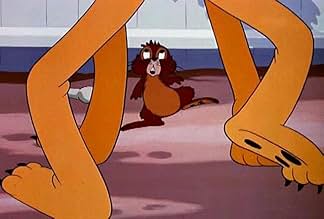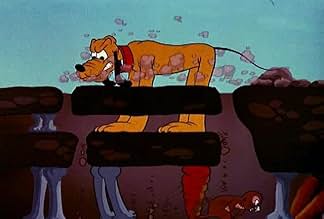Füge eine Handlung in deiner Sprache hinzuPluto's efforts to dig up a bone are frustrated by his allergy to goldenrod, and by a gopher who is using the bone to prop up his tunnel.Pluto's efforts to dig up a bone are frustrated by his allergy to goldenrod, and by a gopher who is using the bone to prop up his tunnel.Pluto's efforts to dig up a bone are frustrated by his allergy to goldenrod, and by a gopher who is using the bone to prop up his tunnel.
- Regie
- Drehbuch
- Hauptbesetzung
James MacDonald
- Pluto
- (Nicht genannt)
Empfohlene Bewertungen
After waking up from a nap, Pluto realizes that there is no bone in his dish. When Pluto tries to locate a bone from his buried stash, he discovers that a gopher has been using the bones to support his tunnels. So, Pluto tries to reclaim his property while the gopher uses pollen-laden flowers to make Pluto let his allergies get the best of him.
This was an OK cartoon. Not much laughs in this film, though - just lots of running around and lots of sneezing. But, the gopher was pretty hilarious - reminds me of the same gopher character in another Pluto cartoon, Canine Caddy.
Grade B-
This was an OK cartoon. Not much laughs in this film, though - just lots of running around and lots of sneezing. But, the gopher was pretty hilarious - reminds me of the same gopher character in another Pluto cartoon, Canine Caddy.
Grade B-
I love animation and I do enjoy the Pluto cartoons. Bone Bandit is not one of my favourites, it is very routine story-wise and it is more mildly amusing than hilarious. However, the animation is beautiful with lovely colours and fluidity in the backgrounds, and the music as always is dynamic and has a fair amount of energy and the cartoons has one of the most epic sneezes I've heard. Pluto is cute and energetic, and the gopher is a good rascally foil.
Overall, Bone Bandit is a decent cartoon but there is nothing mind-blowing in story and gags. The characters are great though, and the cartoon is technically great.
7/10 Bethany Cox
Overall, Bone Bandit is a decent cartoon but there is nothing mind-blowing in story and gags. The characters are great though, and the cartoon is technically great.
7/10 Bethany Cox
The next one to watch in the Disney Plus "shorts" section was this 1948 Pluto story that was a bit better than some of the other ones I've watched from a similar period.
Pluto (James MacDonald) decides that he needs a bone from the stash he's got buried in Mickey's Garden. He discovers that a gopher has been digging underneath the garden and utilising his bones as support struts. Though with an obvious physical advantage, Pluto's attempts are regularly thwarted by his allergies to the plant that is currently in bloom.
I did find the relationship between Pluto and the Gopher to be an interesting one. They're not quite Pro/An tagonist in their interactions, certainly nothing like the same way that Donald and Chip n Dale would prove to be, perhaps because you need a pompous character to be foiled like this for it to be funny, and Pluto is essentially a regular dog. I also found it interesting that Mickey would grow a plant that Pluto is allergic too, seems like a jerk move.
I thought this looked pretty good. By 1948 we've advanced a little further than the basic animation of some of the earlier ones. I particularly liked the side on views that we see, with a cut out of the ground so we can see exactly how the gopher is using the bones in his construction.
It's only seven minutes long, so there's isn't a lot to make much of a decision about, but of the shorts from this era that I've watched so far, this was one of the better ones.
Pluto (James MacDonald) decides that he needs a bone from the stash he's got buried in Mickey's Garden. He discovers that a gopher has been digging underneath the garden and utilising his bones as support struts. Though with an obvious physical advantage, Pluto's attempts are regularly thwarted by his allergies to the plant that is currently in bloom.
I did find the relationship between Pluto and the Gopher to be an interesting one. They're not quite Pro/An tagonist in their interactions, certainly nothing like the same way that Donald and Chip n Dale would prove to be, perhaps because you need a pompous character to be foiled like this for it to be funny, and Pluto is essentially a regular dog. I also found it interesting that Mickey would grow a plant that Pluto is allergic too, seems like a jerk move.
I thought this looked pretty good. By 1948 we've advanced a little further than the basic animation of some of the earlier ones. I particularly liked the side on views that we see, with a cut out of the ground so we can see exactly how the gopher is using the bones in his construction.
It's only seven minutes long, so there's isn't a lot to make much of a decision about, but of the shorts from this era that I've watched so far, this was one of the better ones.
Pluto wants to dig up his bones buried in the middle of the garden. He is confronted by a gopher who is using his bones to support a series of tunnels. In the battle for supremacy, the gopher uses the new flowers to attack Pluto's pollen allergy. I like the gopher. I wonder if the gopher gets used in other shorts. I always thought Disney could use a Bugs Bunny character. He could be sarcastic and a little edgier than Mickey Mouse. The gopher has a bit of that. He just needs a voice. This is a fun one with Pluto who gets to be more than Mickey's dog.
A Walt Disney PLUTO Cartoon.
Pluto discovers that the BONE BANDIT who's been stealing his snacks is a feisty garden gopher.
This is another in a lengthy series of rather routine - but enjoyable - cartoons in which Pluto is confronted by a critter much smaller than himself, the difference here being that the gopher is quite bellicose and very willing to get tough with the Pup.
Walt Disney (1901-1966) was always intrigued by drawings. As a lad in Marceline, Missouri, he sketched farm animals on scraps of paper; later, as an ambulance driver in France during the First World War, he drew figures on the sides of his vehicle. Back in Kansas City, along with artist Ub Iwerks, Walt developed a primitive animation studio that provided animated commercials and tiny cartoons for the local movie theaters. Always the innovator, his ALICE IN CARTOONLAND series broke ground in placing a live figure in a cartoon universe. Business reversals sent Disney & Iwerks to Hollywood in 1923, where Walt's older brother Roy became his lifelong business manager & counselor. When a mildly successful series with Oswald The Lucky Rabbit was snatched away by the distributor, the character of Mickey Mouse sprung into Walt's imagination, ensuring Disney's immortality. The happy arrival of sound technology made Mickey's screen debut, STEAMBOAT WILLIE (1928), a tremendous audience success with its use of synchronized music. The SILLY SYMPHONIES soon appeared, and Walt's growing crew of marvelously talented animators were quickly conquering new territory with full color, illusions of depth and radical advancements in personality development, an arena in which Walt's genius was unbeatable. Mickey's feisty, naughty behavior had captured millions of fans, but he was soon to be joined by other animated companions: temperamental Donald Duck, intellectually-challenged Goofy and energetic Pluto. All this was in preparation for Walt's grandest dream - feature length animated films. Against a blizzard of doomsayers, Walt persevered and over the next decades delighted children of all ages with the adventures of Snow White, Pinocchio, Dumbo, Bambi & Peter Pan. Walt never forgot that his fortunes were all started by a mouse, or that simplicity of message and lots of hard work always pay off.
Pluto discovers that the BONE BANDIT who's been stealing his snacks is a feisty garden gopher.
This is another in a lengthy series of rather routine - but enjoyable - cartoons in which Pluto is confronted by a critter much smaller than himself, the difference here being that the gopher is quite bellicose and very willing to get tough with the Pup.
Walt Disney (1901-1966) was always intrigued by drawings. As a lad in Marceline, Missouri, he sketched farm animals on scraps of paper; later, as an ambulance driver in France during the First World War, he drew figures on the sides of his vehicle. Back in Kansas City, along with artist Ub Iwerks, Walt developed a primitive animation studio that provided animated commercials and tiny cartoons for the local movie theaters. Always the innovator, his ALICE IN CARTOONLAND series broke ground in placing a live figure in a cartoon universe. Business reversals sent Disney & Iwerks to Hollywood in 1923, where Walt's older brother Roy became his lifelong business manager & counselor. When a mildly successful series with Oswald The Lucky Rabbit was snatched away by the distributor, the character of Mickey Mouse sprung into Walt's imagination, ensuring Disney's immortality. The happy arrival of sound technology made Mickey's screen debut, STEAMBOAT WILLIE (1928), a tremendous audience success with its use of synchronized music. The SILLY SYMPHONIES soon appeared, and Walt's growing crew of marvelously talented animators were quickly conquering new territory with full color, illusions of depth and radical advancements in personality development, an arena in which Walt's genius was unbeatable. Mickey's feisty, naughty behavior had captured millions of fans, but he was soon to be joined by other animated companions: temperamental Donald Duck, intellectually-challenged Goofy and energetic Pluto. All this was in preparation for Walt's grandest dream - feature length animated films. Against a blizzard of doomsayers, Walt persevered and over the next decades delighted children of all ages with the adventures of Snow White, Pinocchio, Dumbo, Bambi & Peter Pan. Walt never forgot that his fortunes were all started by a mouse, or that simplicity of message and lots of hard work always pay off.
Wusstest du schon
- VerbindungenFeatured in Rootin' Tootin' Roundup (1990)
Top-Auswahl
Melde dich zum Bewerten an und greife auf die Watchlist für personalisierte Empfehlungen zu.
Details
- Erscheinungsdatum
- Herkunftsland
- Offizieller Standort
- Sprache
- Auch bekannt als
- Bone Bandit
- Produktionsfirma
- Weitere beteiligte Unternehmen bei IMDbPro anzeigen
- Laufzeit7 Minuten
- Seitenverhältnis
- 1.37 : 1
Zu dieser Seite beitragen
Bearbeitung vorschlagen oder fehlenden Inhalt hinzufügen

Oberste Lücke
By what name was Der Knochendieb (1948) officially released in Canada in English?
Antwort


















